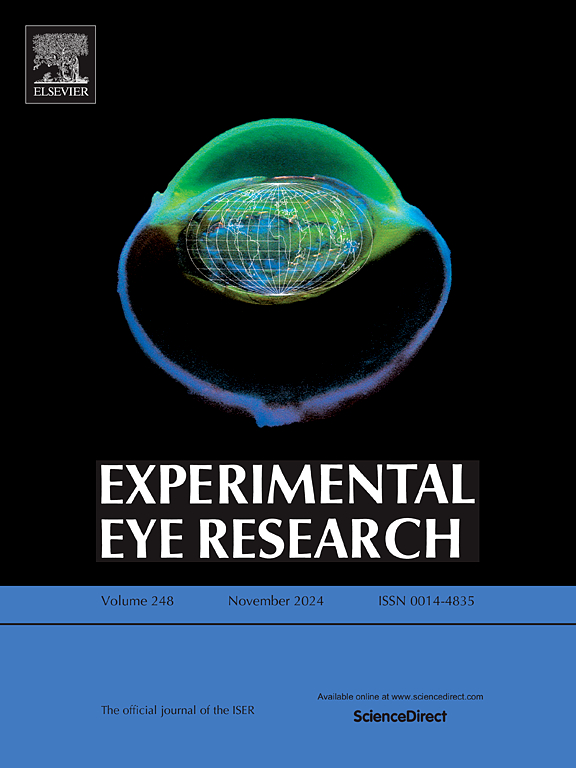LncRNA H19 and miR-138 modulate retinal neovascularization and associated pathological features in hypoxia-induced disease models
IF 3
2区 医学
Q1 OPHTHALMOLOGY
引用次数: 0
Abstract
In this study, we investigated the mechanism of action of the long noncoding RNA (lncRNA) H19 to evaluate potential novel therapeutic targets in retinal neovascular diseases. Following establishment of an oxygen-induced mouse retinopathy (OIR) model, we knocked down lncRNA H19 and microRNA (miR)-138 by intravitreal injection of adenovirus and assessed the outcomes of interference and overexpression by real time quantitative polymerase chain reaction (RT-qPCR). Additionally, we observed vascular lesions of the retina by hematoxylin and eosin staining and retinal paving staining and detected the expression of relevant factors by Western blot, immunohistochemistry, and immunofluorescence. Human retinal endothelial cells (HREC) were cultured and hypoxia models constructed using hypoxia-treated cells to explore the in vitro effects of knockdown and overexpression of lncRNA H19 and miR-138 in hypoxia-treated cells by RT-qPCR. Moreover, we assessed cell migration, proliferation, and cell cycle progression, as well as relationships between lncRNA H19, vascular endothelial growth factor (VEGF), and miR-138.Our experimental results demonstrated significantly upregulated expression of lncRNA H19 and downregulated miR-138 levels in both oxygen-induced retinopathy (OIR) mouse models and hypoxic human retinal endothelial cells (HRECs). Moreover, lncRNA H19 knockdown and miR-138 overexpression reduced pathological changes in the retina and decreased VEGF and hypoxia-inducible factor (HIF)-1α levels. Furthermore, luciferase assays demonstrated targeted binding of miR-138 to sites on H19 and HIF1α. These findings indicated that expression of miR-138 can reduce HIF-1α and H19 levels both directly and through competitive adsorption by H19 and thereby participate in regulating retinal neovascularization.

LncRNA H19和miR-138在缺氧诱导的疾病模型中调节视网膜新生血管和相关病理特征。
在这项研究中,我们研究了长链非编码RNA (lncRNA) H19的作用机制,以评估视网膜新生血管疾病的潜在新治疗靶点。建立氧诱导小鼠视网膜病变(OIR)模型后,通过玻璃体内注射腺病毒敲低lncRNA H19和microRNA miR -138,并通过实时定量聚合酶链反应(RT-qPCR)评估干扰和过表达的结果。采用苏木精、伊红染色、视网膜铺路染色观察视网膜血管病变,western blot、免疫组织化学、免疫荧光检测相关因子的表达。培养人视网膜内皮细胞(HREC),利用缺氧处理细胞构建缺氧模型,采用RT-qPCR方法探讨lncRNA H19和miR-138在缺氧处理细胞中下调和过表达的体外影响。此外,我们评估了细胞迁移、增殖和细胞周期进展,以及lncRNA H19、血管内皮生长因子(VEGF)和miR-138之间的关系。我们的实验结果表明,在氧诱导视网膜病变(OIR)小鼠模型和缺氧的人视网膜内皮细胞(HRECs)中,lncRNA H19的表达均显著上调,miR-138的表达水平均下调。此外,lncRNA H19敲低和miR-138过表达减少了视网膜的病理变化,降低了VEGF和缺氧诱导因子(HIF)-1α水平。此外,荧光素酶测定显示miR-138靶向结合H19和HIF1α上的位点。这些发现表明,miR-138的表达可以直接或通过H19的竞争吸附降低HIF-1α和H19的水平,从而参与调节视网膜新生血管。
本文章由计算机程序翻译,如有差异,请以英文原文为准。
求助全文
约1分钟内获得全文
求助全文
来源期刊

Experimental eye research
医学-眼科学
CiteScore
6.80
自引率
5.90%
发文量
323
审稿时长
66 days
期刊介绍:
The primary goal of Experimental Eye Research is to publish original research papers on all aspects of experimental biology of the eye and ocular tissues that seek to define the mechanisms of normal function and/or disease. Studies of ocular tissues that encompass the disciplines of cell biology, developmental biology, genetics, molecular biology, physiology, biochemistry, biophysics, immunology or microbiology are most welcomed. Manuscripts that are purely clinical or in a surgical area of ophthalmology are not appropriate for submission to Experimental Eye Research and if received will be returned without review.
 求助内容:
求助内容: 应助结果提醒方式:
应助结果提醒方式:


